RX 5600 XT Red Dragon - Ultimate 1080p GPU
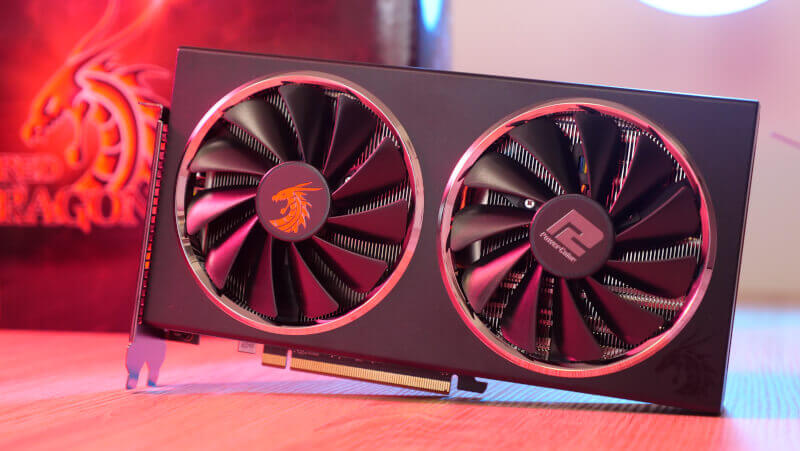
There’s no way around the fact that there has been quite a revival of AMD in recent time, after a long period of standing in the shadow of their rivals. In particular Intel and Nvidia have been outmaneuvering AMD for quite a while. But the tables have turned quite a bit today, or at least one of them, with AMD taking a huge bite of the CPU market. In terms of graphics cards, they are still a bit behind Nvidia when it comes to the high-end market.
But the high-end market constitutes only a small part of the entire market, and by far the majority of graphics cards that are sold belong to the cheaper middle segment.
The latest addition from AMD is the Radeon 5600 XT, which it claims to be the ultimate 1080p graphics card. Today, we take a look at one of these cards with the Red Dragon edition from PowerColor.
Note:
Before we get to the actual test, we want to mention that the graphics card that we’ve received for testing comes directly from AMD. It is an early sample that AMD has acquired, and PowerColor has subsequently made a small change to the graphics card meaning that the final retail version is slightly different compared to our early press sample.
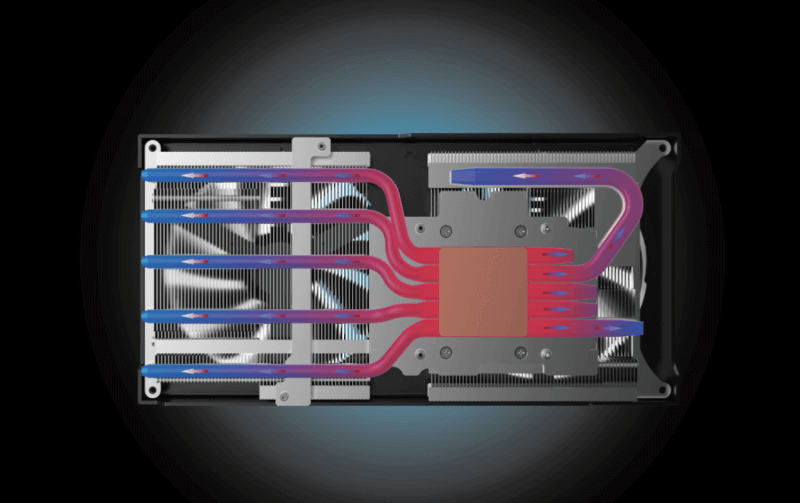
To be more specific, the difference lies in the number of heat pipes that the card is equipped with. Our version of the card has four heat pipes, whereas the retail version comes with five. This of course means that you’ll be able to see a variation in the temperatures and performance between the version that we are testing, and the one that you’ll find on the shelf at your local dealer.
Fortunately, the retail version should in any case be an improvement over the press sample, and this should be detectable in both temperatures as well as in pure performance.
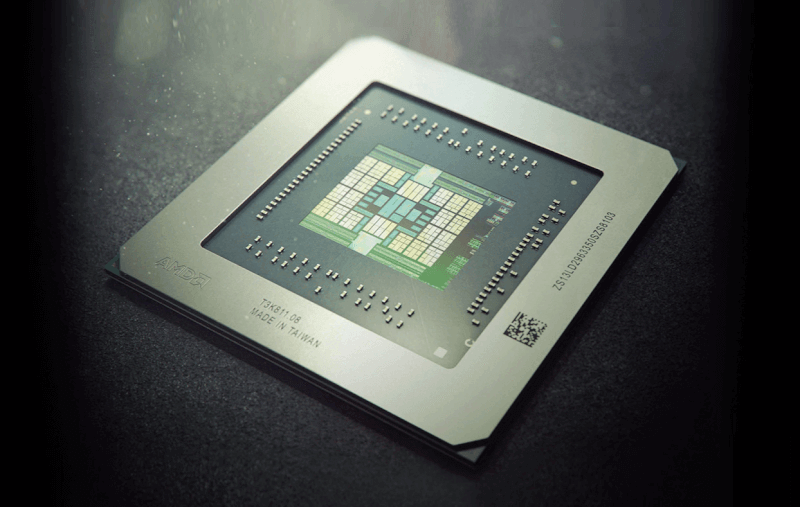
The rest of the press sample, including the GPU chip, is identical to the retail version.
The Specifications of the PowerColor RX 5600 XT Red Dragon
With that out of the way, let’s dive into today’s test. We start by looking at the technical specifications of the graphics card:
Graphics Engine: AXRX 5600XT 6GBD6-3DHR/OC
Video Memory: 6GB GDDR6
Stream Processor: 2304 Units
Engine Clock: 1560 MHz(Game) / up to 1620 MHz (Boost)
Memory Clock: 14.0 Gbps
Memory Interface: 192-bit
DirectX® Support: 12
Bus Standard: PCIE 4.0
Standard Display Connectors: HDMI/ DisplayPort x3
Features:
OpenGL
CrossFireX™ Technology (DirectX® 12/Vulkan™)
AMD Stream Technology
AMD Eyefinity Technology
AMD Hypermemory
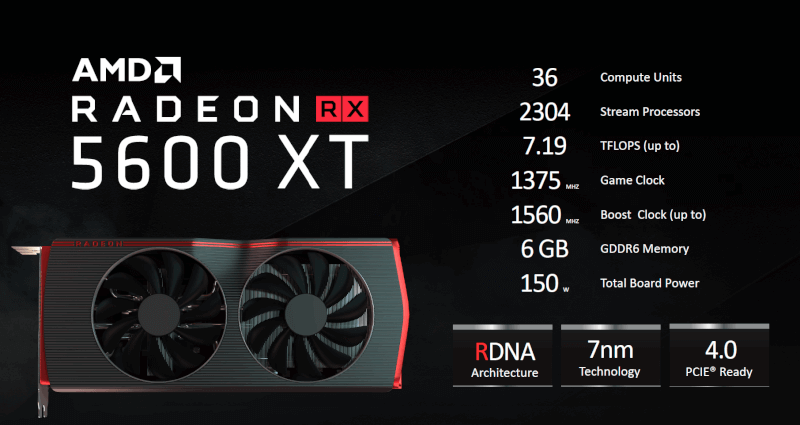
The Radeon 5600 XT graphics card is built with AMD’s 7 nm RDNA architecture, and it comes with 36 compute units, 2304 stream processors and 6 GB GDDR6 RAM on a 192-bit memory bus.
The PowerColor RX 5600 XT Red Dragon also supports PCIe 4.0 despite this not really having any practical impact on the performance of the card.
One of the main selling points, which AMD also highlights, is the 7 nm architecture that allows for more performance to be drawn from the graphics card, compared to earlier models, and at the same time reduces the power consumption.
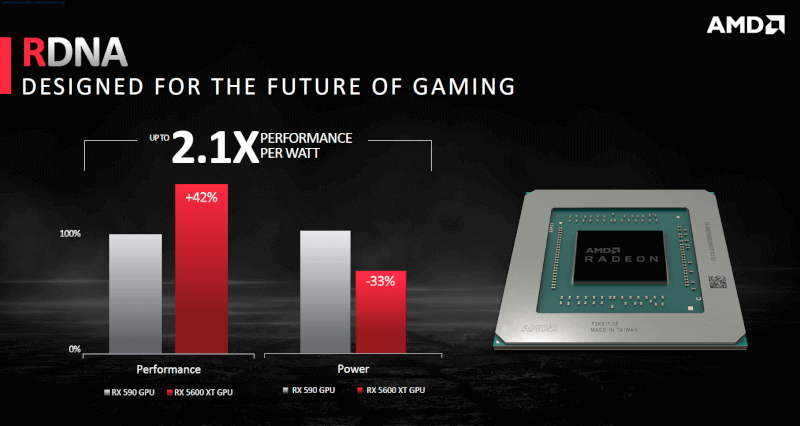
According to AMD’s own comparison to their own RX 590 graphics card, we get a 42% performance boost and at the same time a 33% drop in power consumption.
With the graphics card you also get access to AMD’s Adrenaline software, which, aside from drivers, contains a host of features that will allow you to get the most out of your AMD-based graphics card.
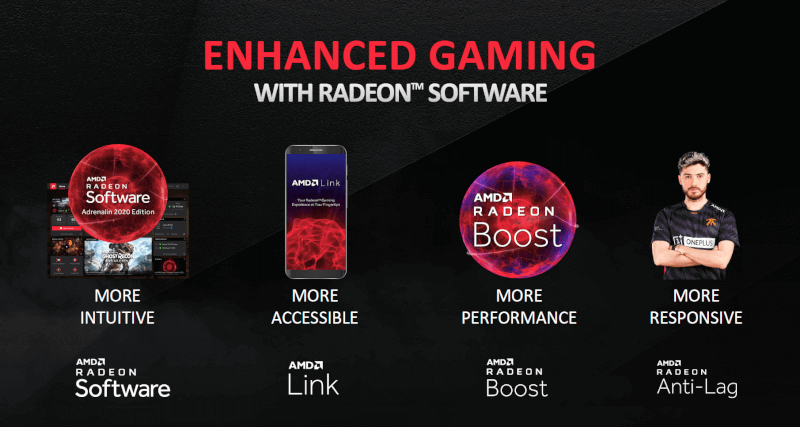
Officially, the boost clock speed is specified, by AMD, to 1560 MHz, and the game clock is expected to be 1375 MHz.
PowerColor claims that with its latest VBIOS update for the graphics card, one can expect the clock speeds to go higher. As such, it specifies a boost clock speed of 1620 MHz and a game clock of 1560 MHz, if you run with the OC BIOS profile. In the Silent BIOS profile, one can expect a game clock of 1460 MHz.
The Design of the PowerColor RX 5600 XT Red Dragon
The graphics card that we have for testing today is the Red Dragon version from PowerColor. PowerColor is one of AMD’s collaborators with the launch of this new series of graphics cards.
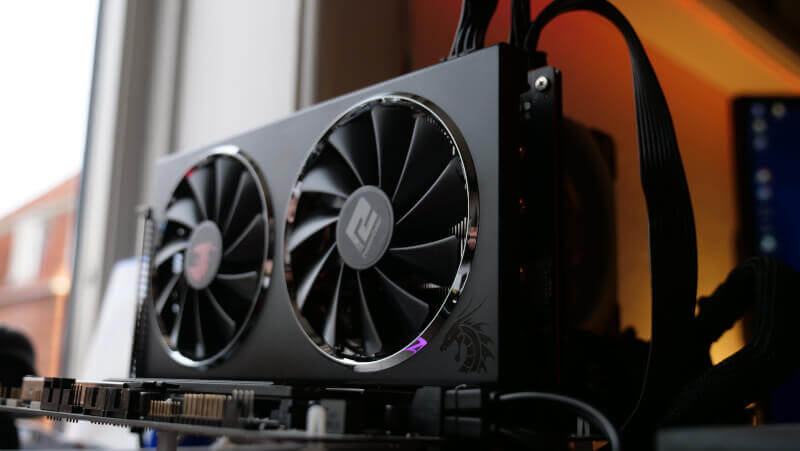
The design of the 5600 XT is similar to that of other graphics cards also from the Red Dragon series. We are met with a subtle design that sports both metal and plastic parts, and no RGB lights whatsoever.
There are silver highlights around the two 100 mm fans that support what PowerColor has dubbed “Mute Fan Technology”. This essentially means that the fans won’t run before the graphics card reaches more than 60 degrees.
On the side of the graphics card there is a white PowerColor logo and on the black backplate, which is made in brushed aluminum, there is a smaller Red Dragon logo in the corner.
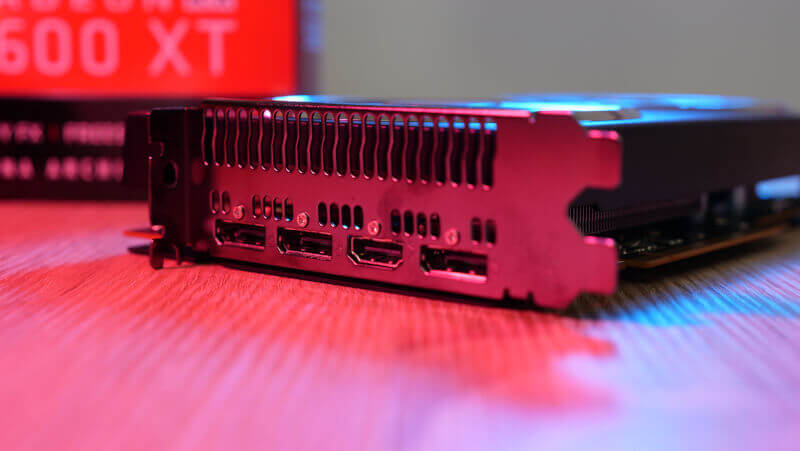
In terms of connectivity, you get three DisplayPorts and a single HDMI port. Other than that, you’ll need a single 8-pin PCIe connector in your system in order to power the graphics card.
All in all, it’s a rather subtle looking graphics card that should fit well into most systems.
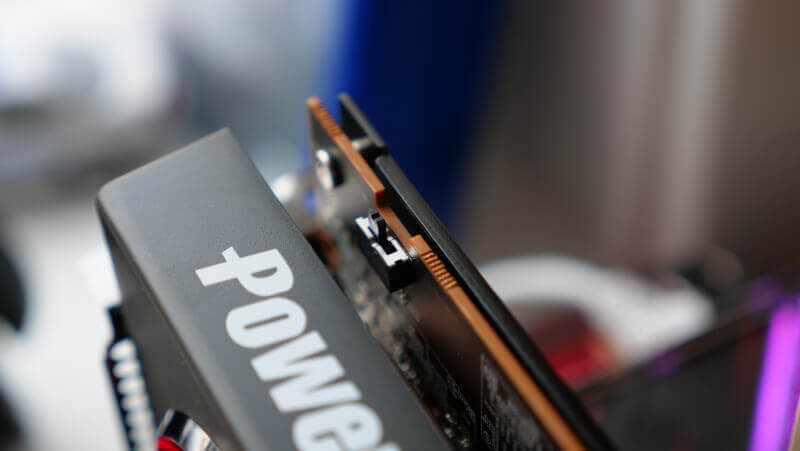
The graphics card is fitted with a BIOS switch that switches the PowerColor RX 5700 XT Red Dragon between Ultra OC and Silent OC, depending on what you prefer.
Testing the PowerColor RX 5600 XT Red Dragon
We’re of course interested in finding out how well the graphics card performs under optimal conditions. As such, all of the benchmarks have been performed with the graphics card set to the OC BIOS profile.
Under full load the graphics card topped at an average clock speed of 1700 MHz, which is well beyond the promised 1620 MHz that PowerColor specifies. The card managed this at a temperature of 74 ℃ and at a very acceptable noise level of 37 dB when using the standard fan curve on the graphics card.
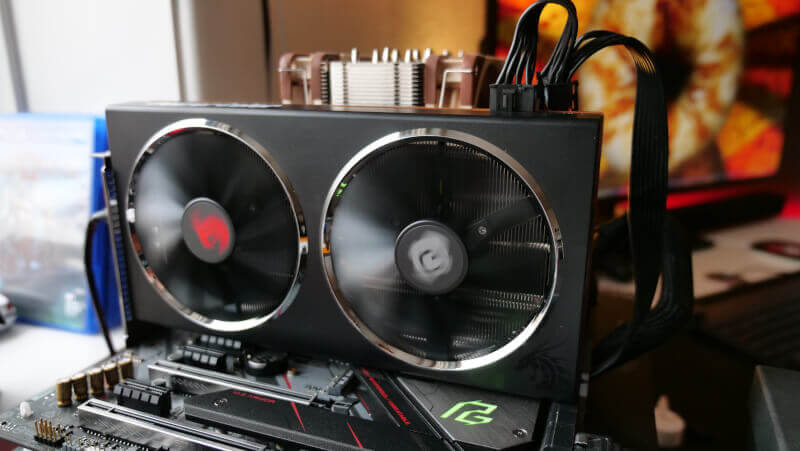
Overall, a very good performance shown by the RX 5600 XT Red Dragon graphics card from PowerColor.
But it all depends on how well these clock speeds are translated into raw performance in our games and benchmarks. AMD promotes the RX 5600 XT as a graphics card targeted at gaming in Full HD (1920x1080), so this is the primary resolution that we’ve targeted in this review. However, we did add 2560x1440 just in order to get an impression of how well the card can pull it off.
The first couple of tests are synthetic benchmarks, and we start with 3DMark Time Spy.
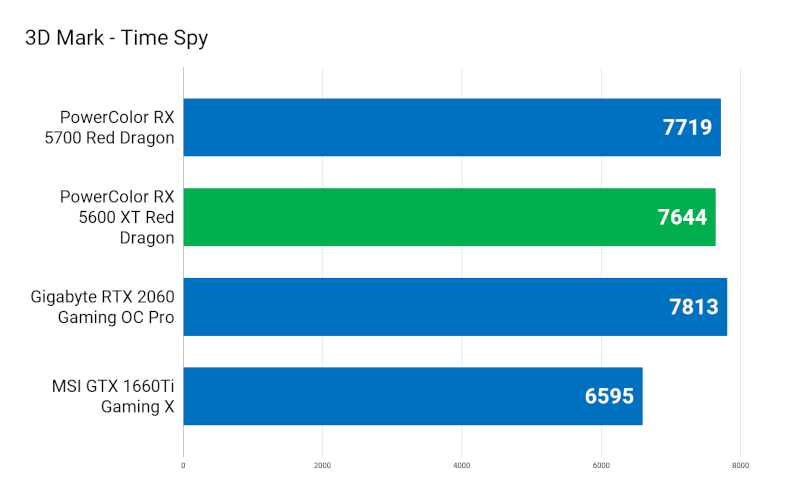
Here, the RX 5600 XT graphics card is right behind its bigger brother, the RX 5700. AMD compares the RX 5600 XT with the GTX 1660 Ti in their promotional material, since they are neck and neck in terms of pricing. Between these two cards, the RX 5600 XT from PowerColor performs convincingly better.
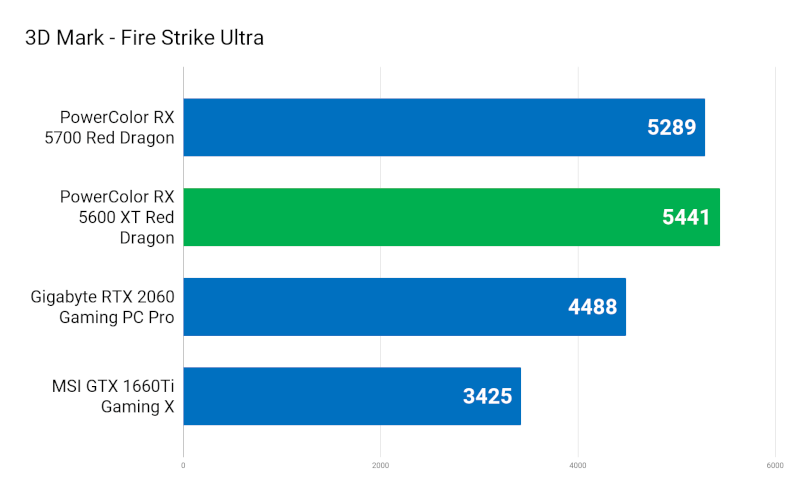
The next test is 3DMark Fire Strike Ultra. Here, the distribution finds the RX 5600 XT at an even bigger advantage. It even manages to surpass the bigger and more expensive RX 5700 that is from the same Red Dragon series from PowerColor.
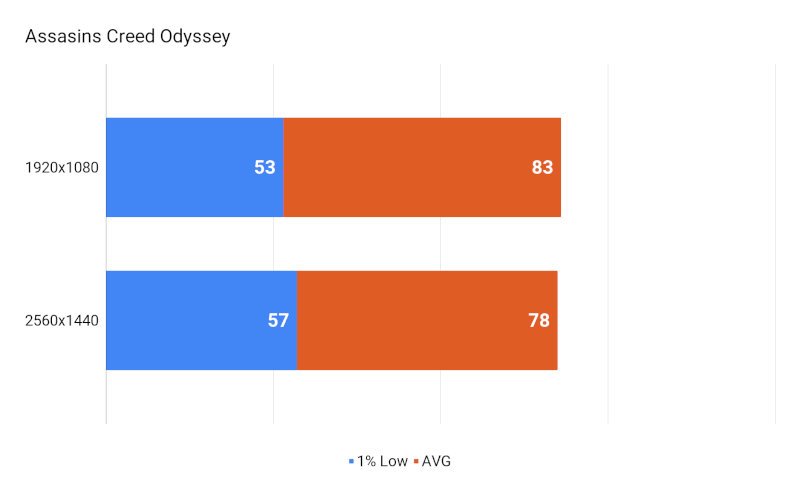
The first game test is that of Assassin’s Creed Odyssey, which belongs to the heavier end of the scale in terms of system requirements. Here, we find that the RX 5600 can easily keep up in 1080p, and to our great surprise, in 1440p it performs almost similarly.
In boths resolutions, we find ourselves well beyond 60 FPS. So, AMD definitely has not made false promises in terms of the 1080p performance.
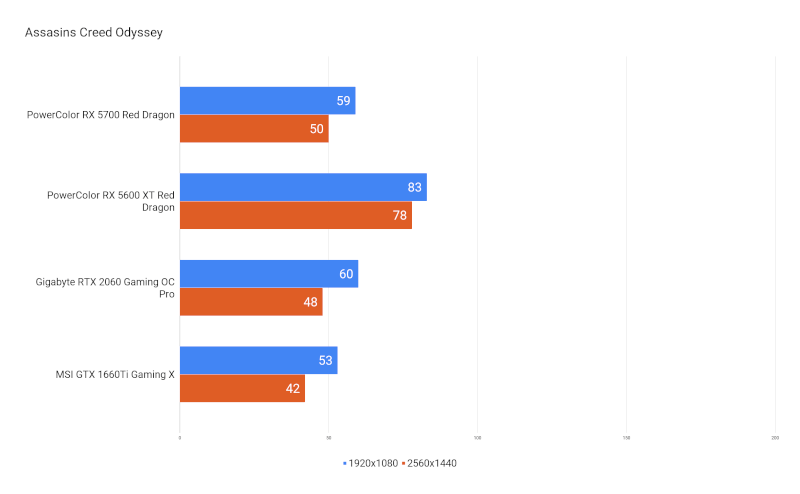
When we look at the comparison chart, we quickly see how well the card actually performs. The RX 5600 XT Red Dragon takes a solid lead over the other cards in the test. Even the bigger RX 5700 graphics card finds itself beat in both 1080p and 1440p.
We do have a suspicion that this might be related to some driver updates that have come since we did the test of the RX 5700 card.Unfortunately, it was not possible to re-do the RX 5700 tests.
Still, the results up against Nvidia makes the RX 5600 XT Red Dragon a clear winner in our test.
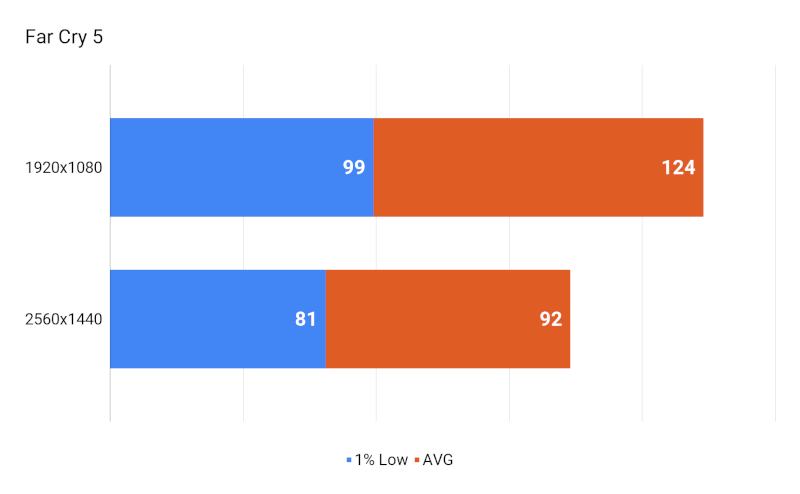
Next up is Far Cry 5, which represents the middle segment in terms of requirements. Again, we see some really solid results. The RX 5600 XT Red Dragon yet again manages to hold its own in both 1080p and 1440p, and it even does this at a level that would allow for the use of a high refresh rate monitor.
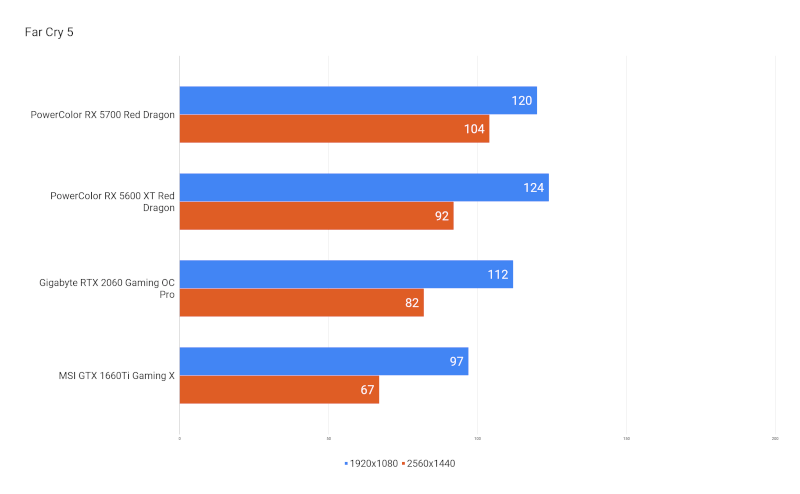
When looking at the comparison chart, we find it, once again, ahead of the bigger RX 5700 graphics card from the same series. The gap down to Nvidia has been closed a bit. Still, it’s a solid victory for the RX 5600 XT, yet again.
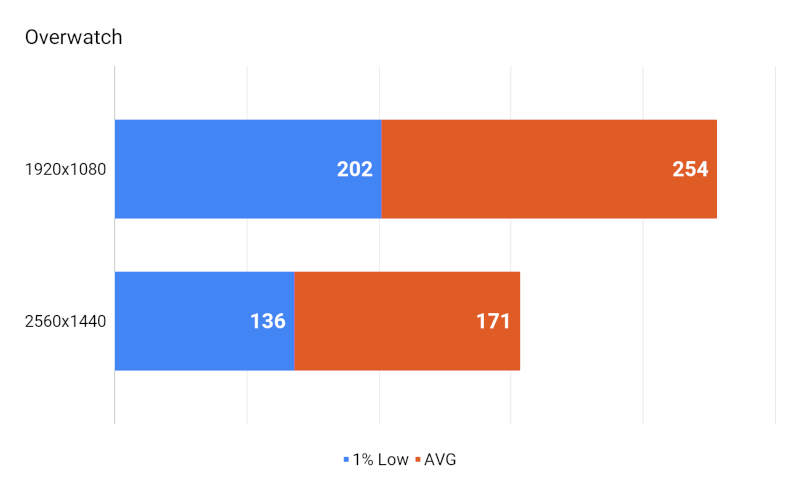
The last game in our test suite is Overwatch, which is a good representation of the e-sport segment, and a less demanding game in general. This is also seen in the results. At 1080p we are close to the 300 FPS engine cap in Overwatch. Also, we are doing really well in 1440p, and once again, we would even be able to make use of a high refresh rate gaming monitor.
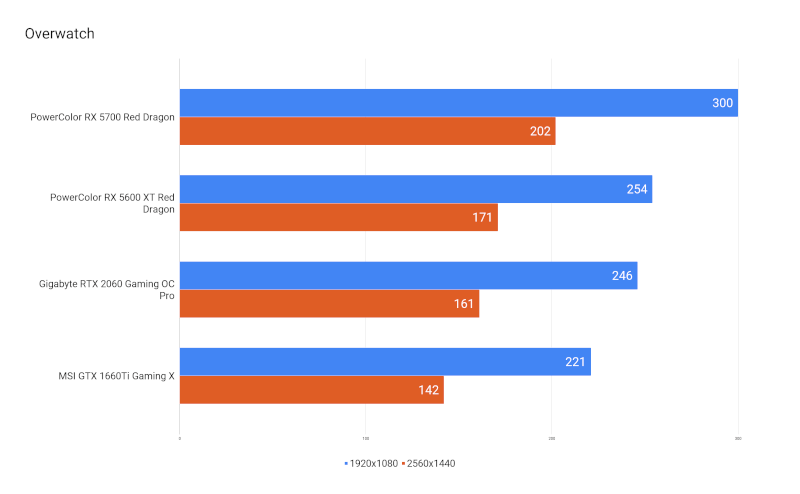
We round it off with a final comparison chart. We see the same tendency as before. The RX 5700 has taken the lead for once. This doesn’t change the fact that the RX 5600 XT Red Dragon still does a remarkable job, and if we also compare to Nvidia’s contenders, there’s no doubt about which card is the winner.
Price
At the time of this writing, the PowerColor RX 5600 XT Red Dragon graphics card can be purchased for $289.99. Compared to the pricing of competing cards, e.g. the Nvidia GTX 1660 Ti and RTX 2060, the RX 5600 XT is a really strong contender at this price point.
Conclusion
In their on promotional material, AMD compares the RX 5600 XT directly with Nvidia’s GTX 1660 Ti, and they do so since both of the cards are priced within the same price margin. The RX 5600 XT Red Dragon lands somewhere between the GTX 1660 Ti and RTX 2060 from Nvidia, and if you take into account that the RX 5600 XT graphics card from PowerColor that we tested beats both of those cards with a substantial gap, then there’s really no doubt where your money is best spent.
You get better performance than with an RTX 2060, just cheaper, which is hard to argue against. Looking at AMD’s own offerings, it might even seem that the RX 5600 XT is a better bargain than the RX 5700. Even though the RX 5700 would probably score better, had we been able to test it with newer drivers, the difference between it and the RX 5600 XT would be so marginal that it still wouldn’t necessarily be worth it.
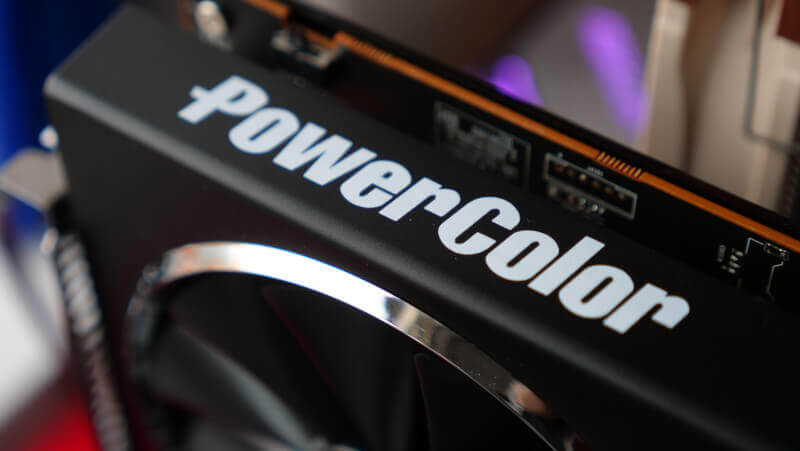
At the time of this writing, the price difference between the RX 5600 XT and RX 5700 is around $70, and with that in mind, we definitely feel that the RX 5600 XT is the best bargain.
PowerColor’s Red Dragon that we’ve looked at in today’s test delivered some really reasonable noise levels. If you have it installed in a standard case, you’d be hard pressed to even hear it.
As mentioned earlier, do keep in mind that the sample that we’ve tested is not entirely the same as the retail version.
The retail version will feature an additional heat pipe, and this should no doubt lead to even lower temperatures. However, we wouldn’t expect the performance to be much different.

That’s not really necessary anyways since the RX 5600 XT Red Dragon from PowerColor is a really solid graphics card at its price. It beats Nvidia’s cards from the same price segment without even breaking a sweat, and it even manages to compete with its bigger brother, the RX 5700.
We wouldn’t hesitate one bit in recommending the RX 5600 XT graphics card from Red Dragon for both Full HD and 1440p gaming.
We arrive at a final score of 9 and a Great Product Award for a graphics card that beats its competition both in performance and pricing.


Latest graphics card
-
07 Jangraphics card
-
07 Jangraphics card
ASUS ready with large selection of RTX 50 graphics
-
07 Jangraphics card
Nvidia Reflex 2 reduces gaming latency
-
07 Jangraphics card
Nvidia launches DLSS 4 with the new RTX 50 series
-
07 Jangraphics card
Nvidia RTX 50 series is ready
-
07 Jangraphics card
Nvidia launches RTX 5090 at CES
-
17 Decgraphics card
Boost your gaming with Nvidia
-
26 Auggraphics card
Intel Arc 140V and 130V GPUs confirmed
Most read graphics card
Latest graphics card
-
07 Jangraphics card
ASUS showcases new AMD RX 9700 graphics cards
-
07 Jangraphics card
ASUS ready with large selection of RTX 50 graphics
-
07 Jangraphics card
Nvidia Reflex 2 reduces gaming latency
-
07 Jangraphics card
Nvidia launches DLSS 4 with the new RTX 50 series
-
07 Jangraphics card
Nvidia RTX 50 series is ready
-
07 Jangraphics card
Nvidia launches RTX 5090 at CES
-
17 Decgraphics card
Boost your gaming with Nvidia
-
26 Auggraphics card
Intel Arc 140V and 130V GPUs confirmed






